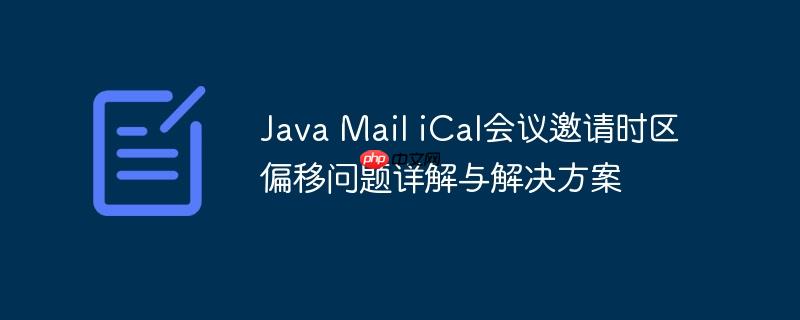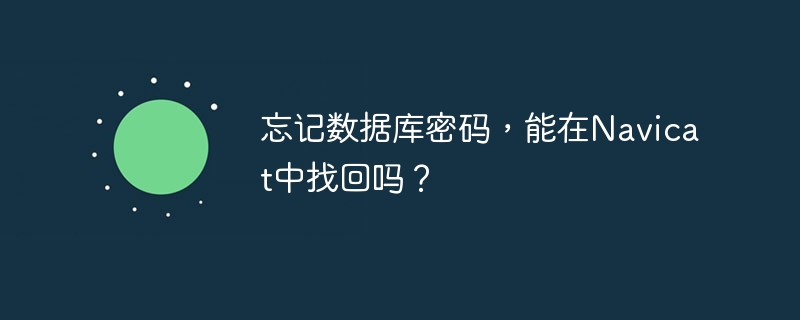
本文旨在解决Java Mail发送iCal会议邀请时因时区处理不当导致的会议时间偏移问题。核心问题在于iCal DTSTART和DTEND属性末尾的’Z’字符,它将时间指定为UTC,从而忽略了本地时区设置。教程将详细介绍iCal时间格式规范,并提供基于Java java.time API的解决方案,通过明确指定时区ID(TZID)来确保会议时间在接收方日历中正确显示。
1. 问题背景与根本原因
在使用java mail api发送ical格式的会议邀请时,开发者常遇到一个棘手的问题:会议邀请中显示的时间与实际设置的时间存在偏移,例如相差一小时。这通常发生在存在夏令时或不同时区的场景中。
经过分析,问题的根源在于iCal数据中DTSTART(开始时间)和DTEND(结束时间)属性的格式。原始代码中,时间字符串末尾被追加了字符Z,例如DTSTART:20201208T040000Z。根据RFC 5545(iCalendar规范),Z字符表示该时间是协调世界时(UTC)。这意味着,无论您在发送端设置的是哪个本地时间,一旦加上Z,接收方的日历客户端都会将其解释为UTC时间,并根据接收方本地的时区设置进行转换显示。如果接收方所在时区与UTC有偏移(例如柏林在冬季是UTC+1,夏令时是UTC+2),就会出现时间偏移。
2. iCal时间表示规范
RFC 5545定义了三种主要的时间表示方式,这对于理解和解决时区问题至关重要:
- 本地时间 (Local Time): 不带任何时区标识。例如:DTSTART:19970714T133000。这种格式依赖于接收方客户端的默认时区设置,可能导致不确定性。
- UTC时间 (UTC Time): 时间字符串末尾带有Z字符。例如:DTSTART:19970714T173000Z。明确表示该时间是UTC。
- 带有时区引用的本地时间 (Local Time with Time Zone Reference): 使用TZID参数指定一个IANA时区ID。例如:DTSTART;TZID=America/New_York:19970714T133000。这是最推荐的方式,因为它明确指定了时间所属的特定时区,确保了在不同客户端和时区之间的一致性。
3. 解决方案:使用TZID明确指定时区
为了确保iCal会议邀请的时间准确无误,最佳实践是采用“带有时区引用的本地时间”格式,即在DTSTART和DTEND属性中添加TZID参数。
Java 8及更高版本提供的java.time包(JSR-310)是处理日期和时间的强大工具,它完美支持时区操作。我们将使用ZonedDateTime、ZoneId和DateTimeFormatter来构建正确的iCal时间字符串。
立即学习“Java免费学习笔记(深入)”;
3.1 核心Java代码示例
以下代码片段展示了如何使用java.time来生成带有时区信息的iCal时间字符串:
import java.time.LocalDate; import java.time.LocalTime; import java.time.Month; import java.time.ZoneId; import java.time.ZonedDateTime; import java.time.format.DateTimeFormatter; public class ICalTimeZoneExample { public static void main(String[] args) { // 假设的会议日期和时间 LocalDate meetingDate = LocalDate.of(2020, Month.DECEMBER, 8); LocalTime meetingStartTime = LocalTime.of(4, 0); // 04:00 LocalTime meetingEndTime = LocalTime.of(6, 0); // 06:00 // 指定会议所在的时区,例如“Europe/Berlin” ZoneId berlinZone = ZoneId.of("Europe/Berlin"); // 创建ZonedDateTime对象,它包含了日期、时间以及时区信息 ZonedDateTime startDateTime = ZonedDateTime.of(meetingDate, meetingStartTime, berlinZone); ZonedDateTime endDateTime = ZonedDateTime.of(meetingDate, meetingEndTime, berlinZone); // 定义iCal所需的日期时间格式 (yyYYMMDDTHHMMSS) // 注意:这里不再需要'Z'字符,因为我们通过TZID指定了时区 DateTimeFormatter iCalFormatter = DateTimeFormatter.ofPattern("yyyyMMdd'T'HHmmss"); // 格式化后的时间字符串 String formattedStartDate = iCalFormatter.format(startDateTime); String formattedEndDate = iCalFormatter.format(endDateTime); // 生成DTSTART和DTEND属性字符串 String dtStartString = String.format("DTSTART;TZID=%s:%s", startDateTime.getZone().getId(), formattedStartDate); String dtEndString = String.format("DTEND;TZID=%s:%s", endDateTime.getZone().getId(), formattedEndDate); System.out.println("生成的DTSTART字符串: " + dtStartString); System.out.println("生成的DTEND字符串: " + dtEndString); // 示例输出: // 生成的DTSTART字符串: DTSTART;TZID=Europe/Berlin:20201208T040000 // 生成的DTEND字符串: DTEND;TZID=Europe/Berlin:20201208T060000 } }
3.2 将解决方案集成到Java mail代码中
现在,我们将上述逻辑集成到原始的Java Mail发送iCal邀请的代码中。关键在于修改StringBuffer中构建iCal内容的DTSTART和DTEND行。
import javax.activation.DataHandler; import javax.mail.*; import javax.mail.internet.*; import javax.mail.util.ByteArrayDataSource; import java.io.IOException; import java.time.LocalDate; import java.time.LocalTime; import java.time.ZoneId; import java.time.ZonedDateTime; import java.time.format.DateTimeFormatter; import java.util.Properties; public class MeetingInviteSender { public static void main(String[] args) { // 邮件认证信息 (请替换为您的实际信息) final String username = "your_email@gmail.com"; final String password = "your_app_password"; // 如果使用Gmail,可能是应用专用密码 String from = "your_email@gmail.com"; String to = "recipient_email@example.com"; String subject = "Meeting Subject (Corrected Timezone)"; String emailBody = "Hi Team, This is meeting description. Thanks"; // 1. 定义会议的日期、时间以及所在时区 LocalDate meetingDate = LocalDate.of(2020, Month.DECEMBER, 8); LocalTime meetingStartTime = LocalTime.of(4, 0); // 例如,柏林时间04:00 LocalTime meetingEndTime = LocalTime.of(6, 0); // 例如,柏林时间06:00 ZoneId meetingZone = ZoneId.of("Europe/Berlin"); // 指定柏林时区 // 2. 创建ZonedDateTime对象 ZonedDateTime startDateTime = ZonedDateTime.of(meetingDate, meetingStartTime, meetingZone); ZonedDateTime endDateTime = ZonedDateTime.of(meetingDate, meetingEndTime, meetingZone); // 3. 定义iCal所需的日期时间格式 (不带'Z') DateTimeFormatter iCalFormatter = DateTimeFormatter.ofPattern("yyyyMMdd'T'HHmmss"); // 4. 格式化时间字符串 String formattedStartDate = iCalFormatter.format(startDateTime); String formattedEndDate = iCalFormatter.format(endDateTime); try { Properties prop = new Properties(); prop.put("mail.smtp.auth", "true"); prop.put("mail.smtp.starttls.enable", "true"); prop.put("mail.smtp.host", "smtp.gmail.com"); prop.put("mail.smtp.port", "587"); // 通常Gmail使用587端口进行TLS Session session = Session.getInstance(prop, new javax.mail.Authenticator() { protected PasswordAuthentication getPasswordAuthentication() { return new PasswordAuthentication(username, password); } }); MimeMessage message = new MimeMessage(session); message.addHeaderLine("method=REQUEST"); message.addHeaderLine("charset=UTF-8"); message.addHeaderLine("component=VEVENT"); message.setFrom(new InternetAddress(from, "New Outlook Event")); message.addRecipient(Message.RecipientType.TO, new InternetAddress(to)); message.setSubject(subject); StringBuffer sb = new StringBuffer(); StringBuffer buffer = sb.append("BEGIN:VCALENDARn" + "PRODID:-//Microsoft Corporation//Outlook 9.0 MIMEDIR//ENn" + "VERSION:2.0n" + "METHOD:REQUESTn" + "BEGIN:VEVENTn" + "ATTENDEE;ROLE=REQ-PARTICIPANT;RSVP=TRUE:MAILTO:" + to + "n" + // 关键修改:使用TZID和格式化后的本地时间 "DTSTART;TZID=" + startDateTime.getZone().getId() + ":" + formattedStartDate + "n" + "DTEND;TZID=" + endDateTime.getZone().getId() + ":" + formattedEndDate + "n" + "LOCATION:Conference roomn" + "TRANSP:OPAQUEn" + "SEQUENCE:0n" + "UID:040000008200E00074C5B7101A82E00800000000002FF466CE3AC5010000000000000000100n" + " 000004377FE5C37984842BF9440448399EB02n" + // UID通常需要是唯一的,这里仅为示例 "CATEGORIES:Meetingn" + "DESCRIPTION:" + emailBody + "nn" + "SUMMARY:Test meeting requestn" + "PRIORITY:5n" + "CLASS:PUBLICn" + "BEGIN:VALARMn" + "TRIGGER:PT1440Mn" + "ACTION:DISPLAYn" + "DESCRIPTION:Remindern" + "END:VALARMn" + "END:VEVENTn" + "END:VCALENDAR"); // Create the message part BodyPart messageBodyPart = new MimeBodyPart(); // Fill the message messageBodyPart.setHeader("Content-Class", "urn:content-classes:calendarmessage"); messageBodyPart.setHeader("Content-ID", "calendar_message"); messageBodyPart.setDataHandler(new DataHandler( new ByteArrayDataSource(buffer.toString(), "text/calendar")));// very important // Create a Multipart Multipart multipart = new MimeMultipart(); // Add part one multipart.addBodyPart(messageBodyPart); // Put parts in message message.setContent(multipart); // send message Transport.send(message); System.out.println("Email sent!"); } catch (MessagingException me) { me.printStackTrace(); } catch (IOException ex) { ex.printStackTrace(); } catch (Exception ex) { ex.printStackTrace(); } } }
4. 注意事项与最佳实践
- IANA时区数据库: ZoneId.of()方法接受符合IANA时区数据库(如”Europe/Berlin”, “America/New_York”, “Asia/Shanghai”)的字符串。请确保使用正确的时区ID。
- UID的唯一性: iCal中的UID属性应是全局唯一的。在生产环境中,您应该生成一个UUID来作为UID,而不是使用硬编码的示例值。
- 夏令时处理: ZonedDateTime会自动处理夏令时转换。当您指定一个时区ID时,java.time会根据该时区的规则自动调整日期和时间,从而避免了手动计算夏令时的复杂性。
- SMTP端口: 确保SMTP服务器的端口配置正确。例如,Gmail的TLS/STARTTLS通常使用587端口,ssl/SMTPS使用465端口。
- 邮件认证: 如果使用Gmail等第三方SMTP服务,可能需要生成应用专用密码,而不是直接使用您的账户密码,以增强安全性。
通过遵循这些指导原则,并利用java.time API的强大功能,您可以确保Java Mail发送的iCal会议邀请在世界各地都能准确无误地显示正确的会议时间。

















